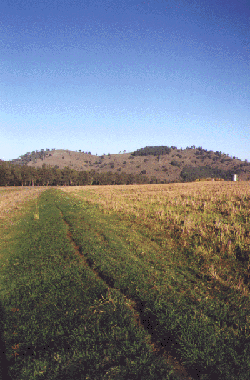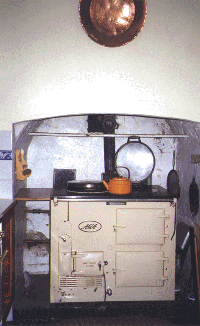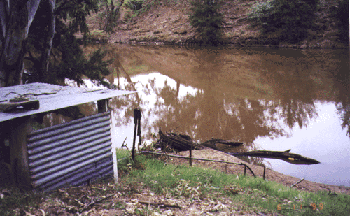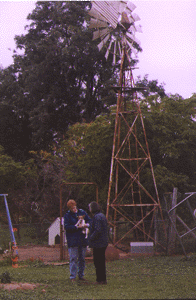ISSUES OF FARMING AND WATER
![]()
ISSUES OF FARMING AND WATER
![]()
What is more basic to life? We just turn on the tap and water flows freely, hot and cold, cool showers, warm tubs. Have you ever thought about where it comes from? How water gets to us? How safe is it? How much do we have? If you are a typical American who has never visited a farm, you have not thought of these issues.On my recent trip to Australia, I traveled to the farm country, 370 kilometers (that's approximately 221 miles) from the coast over the Blue Mountains to the Macquarie Valley. It is a countryside with gently rolling hills, spotted with eucalyptus--and a place where much of Australia's food supply is grown. We visited "The Wuuluman," the sheep farm of Bob and Wendy Blake. They live about 20 km from Wellington in New South Wales. They live along the Macquarie River in a 1908 farmhouse atop a knoll overlooking their sheep paddock (pastures to us). They run up to 2000 sheep on their property. King parrots, lorikeets, kites, sulfur-crested parrots, and gullah fly among the trees. About 500 kangaroo share the upper pastures with the sheep.
Entrance to "The Wuuluman" sheep ranch in New South Wales. Notice that trespassers will be persecuted!
The Stans's (Red noses) and the Blakes (plain noses) on the veranda of the Blakes' farm homestead.
Sheep in the paddock.
The Macquarie River, one source of farm water.
Kangaroos roam the hills with the sheep.
Does it sound bucolic? Definitely, but beneath is the complex issue of water. Water can make or break a farmer. Farmers are not only prone to the vagaries of the commodity market and world politics of quotas, but they are threatened with seasonal droughts. Anticipating and preparing for dry periods and rationing water become critical to survival.
![]()
Rainwater
The farm gets water two ways. First, rainfall is the most desired source of water. Rainwater is collected in earthen reservoirs in the paddock for the sheep. The one in the picture had sprung a leak.
Rain is collected for the sheep in reservoirs dug by tractors in the paddocks. Terraces are built along the contour of the hilly land to prevent erosion and retain the precious rain for the land.

The farm is terraced by tractor to prevent water runoff and stop erosion.
Rainwater is also collected in a 2500 gallon tank just below eaves level of the house.
Rain water is pumped to the tank near the house, river water to the lower one, and the tall one on the left provides water pressure to the house using either rainwater or river water. The green one on the right stores the rainwater that falls onto the roof. During a storm, rainwater run-off is collected from the corrugated iron roof through a system of gutters that fill the rainwater tank. The water from rain is quite pure in this area of Australia. The district has a 26-inch annual rainfall, good by many standards, area yet droughts do occur. In comparison, south and central Florida has an average of 53" of rainfall a year (SFWMD 1999). When the rain tank is empty the farmer must switch the river water for washing and bathing. When they switch to river water, drinking and cooking water is bought in town in 20 liter and 2 liter containers for consumption. Wendy and Bob set containers of water near the bathroom and kitchen sink and to remind guests to use the pure water.

Water is heated for dishes and bathing by flowing through pipes in this stove. In winter, the stove heats the house as well.
River Water
The second way to get water is from the river. Water is pumped uphill from the river to a 20,000-gallon concrete reservoir in the side yard.
The pump carries water from the river to the concrete reservoir or household tank.
The reserve concrete tank which holds water for the garden and animals.] Usually farmers also run crops with the sheep--forage for winter or a vegetable or grain crop--which of course is dependent on rainfall as well.
The river at the Wuuluman is 12 kilometers from the dam wall upstream. The dam when full, it is about the size of Sydney Harbor. The Department of Land and Water Resources regulate water levels in the dam. During a recent prolonged drought, the department allowed the water capacity to drop to 1.5 percent of its volume. Farmers not on the river purchase water from the department in megaliters by what they need. During a drought, rather than reduce the rations, the department draws down the water level to dangerously low level. People who live along the river do not pay for the river's water. The farmers along the river below have no control over the allocation and sale of water in the dam to the vegetable farmers whose property does not abut the river.
In Times of Drought
After several years of drought and temperatures over 44 degrees Celsius (approx. 108 Fahrenheit) the water was critically low in the dam. The water below the dam in the river was green and fish were dying. Ranchers were warned not to supply the water to the cows--not to mention humans. Calls to the department were of no avail. The river farms were forced to use the downstream water because they had no alternative. Although they used the river water to shower, wash and feed the animals, they had to purchase bottled. When rainwater is scarce, river water must be substituted for washing, toilettes, and farm animals. River water is harmful for toilettes because algae will clog the pipes. AND it cannot be drunk. When water is low, so is the pressure and no one can take a shower when the washing machine is on. The farmers are very conscious of water's value and scarcity and are cautious with rinsing dishes, flushing toilettes, and brushing teeth.After three years of drought and low lamb prices, the farm was switched to river water. It was not until we arrived after a rain did Wendy switch over to rainwater. To do this she must climb the tank to flush out all the river water in the system, place enough rainwater in the main tank and flush out the pipes with clean water. Then she pumped the rainwater into the main tank for use in the house. River water still went to the garden and animals.
Because farming is marginal in times of drought and low prices, farmers mostly make do by patching old machinery. To purchase a "drill" or install a well requires applying and waiting for a permit and a large cost outlay.

A neighbor has a windmill to pump readily available subterranean water. Credit to buy windmills and drill is not an option as any cash is tied up in the mortgage on the farm or automobiles and lorries (trucks).
I became so aware that water was precious that I found myself doing all those things I had heard of during our own times of water rationing. I turned off the water when brushing my teeth. I took quick showers. I did not wash my car and I conserved on laundry.
For farmers in the Macquarie valley, sufficient water is a critical issue. Having sufficient rainfall is an issue not controllable by humans. The issues that do require human intervention are complicated by several factors. Who has access to the reserved water? What rates will they pay? How will the water be allocated in times of scarcity? What is the water quality? What technology is involved in reserving rainwater? How do residents adjust their behavior in times of plenty and scarcity? Who owns or regulates the upstream water? Is regulation a communal process? Do individuals have a say in water policy?
Now think about our situation in Southwest Florida. Where does our water come from? How do we use it? What rates do people pay? Do rates vary by consumer? Why do we have water rationing? What happens to our rainfall? Would you like to use the water from our rivers?
Here's a hint. Fort Myers water comes from this intake system along a body of water. Do you know where it is?
BIBLIOGRAPHY:
Blake, Robert and Wendy. Personal Communication. June 11-13,1999. Wellington, New South Wales, Australia.South Florida Water Management District (SFWMD). August 15, 1999.
POSSIBLE SHORT PAPERS:
Using the same questions from above, follow our energy supply, our air quality, and other natural resources. What are the issues involved in management of our resources?Where does city water come from?
Is Southwest Florida's air polluted?
What about oil resources? Do we have enough to run out cars and toys in the next millennium/
How long can we use Florida soil, before it is depleted of nutrients?